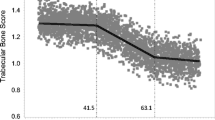Abstract:
Complementing measurements of bone mass with measurements of the architectural status of trabecular bone is expected to improve predictions of fracture risk in osteoporotic patients and improve the assessment of response to drug therapy. With high-resolution MRI the trabecular network can be imaged with 156×156×500 mm3 voxels, sufficient to depict individual trabeculae, albeit with inaccurate thickness. In this work, distance transformation techniques were applied to the three-dimensional image of the distal radius of postmenopausal patients. Structural indices such as trabecular number (app.Tb.N), thickness (app.Tb.Th) and separation (app.Tb.Sp) were determined without model assumptions. A new metric index, the apparent intra-individual distribution of separations (app.Tb.Sp.SD), is introduced. The reproducibility of the MR procedure and structure assessment was determined on volunteers, and the coefficient of variation was found to be 2.7–4.6% for the mean values of structural indices and 7.7% for app.Tb.Sp.SD. The distance transformation methods were then applied to two groups of patients: one of postmenopausal women without vertebral fracture and one of postmenopausal women with at least one vertebral fracture. It was found that app.Tb.Sp.SD discriminates fracture subjects from non-fracture patients as well as dual-energy X-ray absorptiometry (DXA) measurements of the radius and the spine, but not as well as DXA of the hip. Using receiver operating characteristic analysis, the area under the curve (AUC) values were 0.67 for app.Tb.Sp.SD, 0.72 for DXA radius, 0.67 for DXA spine and 0.81 for DXA of the hip. A combination of MR indices reached an AUC of 0.75. Age-adjusted odds ratio ranged from 1.85 to 2.03 for app.Tb.N, app.Tb.Sp and app.Tb.Sp.SD (p<0.003). We conclude that in vivo high-resolution MRI not only has the potential of imaging trabecular bone, but in combination with novel metrics may offer new insight into the structural changes occurring in postmenopausal women.
Similar content being viewed by others
Author information
Authors and Affiliations
Additional information
Received: 7 November 2000 / Accepted: 20 August 2001
Rights and permissions
About this article
Cite this article
Laib, A., Newitt, D., Lu, Y. et al. New Model-Independent Measures of Trabecular Bone Structure Applied to In Vivo High-Resolution MR Images . Osteoporos Int 13, 130–136 (2002). https://doi.org/10.1007/s001980200004
Issue Date:
DOI: https://doi.org/10.1007/s001980200004




